|
RELATIONSHIP BETWEEN
ENVIRONMENTAL FACTORS AND WHITE SHRIMP ABUNDANCE IN THE SOUTHWESTERN GULF OF
MEXICO.
Trabajo recibido el 5 de julio de 1989 y aceptado para su
publicación el 1 de septiembre de 1989.
Adolfo Gracia G.
Instituto de Ciencias del Mar y Limnología, Universidad
Nacional Autónoma de México, Apartado Postal 04510,
México, D.F. Contribución No. 656 del Instituto de Ciencias del
Mar y Limnología, UNAM.
Se analiza la influencia de
parámetros ambientales (descarga fluvial, lluvia, viento y temperatura)
sobre la abundancia del camarón blanco Penaeus
setiferus en la Sonda de Campeche durante el período 1974-1984
y en los juveniles de la Laguna de Términos (19791982) mediante
correlaciones simples y análisis de regresión múltiple. La
descarga fluvial se identificó como la variable ambiental de mayor
influencia sobre las variaciones de la abundancia del camarón blanco en
las fases estuarina y marina. En la etapa juvenil la descarga fluvial del
río Palizada fue la variable indicadora mas importante y presentó
una relación gaussiana con la abundancia del camarón. La descarga
fluvial también fue importante en la abundancia total, de reproductores
y de reclutas del camarón blanco en el ambiente marino. Los modelos
descriptivos de la abundancia mensual total, de reproductores y reclutas
basados en la descarga acumulada con diferentes períodos de retraso
explicaron 43, 48 y 60 % de la varianza. La varianza explicada de la abundancia
total, de reproductores y de reclutas aumentó con la ordenación
de la captura en años biológicos. La descarga fluvial de los tres
ríos durante la temporada de lluvias explicó 78 % de la
variación de la captura por unidad de esfuerzo (CPUE) total y 81 % de la
abundancia de reproductores. En el modelo de la captura por unidad de esfuerzo
de reclutas se explica 58 % de la varianza con la inclusión de la
descarga fluvial durante estío. Se sugiere que el efecto principal de la
descarga fluvial sobre la abundancia del camarón blanco resulta de la
interacción con el hábitat estuarino, lo cual determina la
magnitud del área disponible para el establecimiento de las etapas
estuarinas y en consecuencia el éxito de las
cohortes.
The influence of the following
environmental parameters on the abundance of white shrimp (Penaeus
setiferus) in the Campeche Sound are analyzed: fluvial discharge,
rainfall, wind and temperature. Simple correlation and multiple regression
analysis were applied to the 1974-1984 catch period, including the juveniles
(1979-1982) of the Terminos Lagoon. Fluvial flow was determined as the main
environmental variable which influences the variation in abundance observed for
the white shrimp during the estuarine and marine stages. In the juvenile stage
the Palizada river discharge was the most important predictor, showing a
Gaussian relationship with shrimp abundance. Rivers'discharge also affected the
abundance of reproductive organisms in the marine environment. Based on the
cummulatived discharge of three rivers during different lag periods, the
descriptive models for recruits, spawners and total abundance per month
accounted for 43, 48 and 50% of the observed variance. Explained Variance
increased with the catch arranged in biological years. The discharge from the
three rivers throughout the season explained 78% of the variation of catch per
unit effort (CPUE), and 81% of spawners abundance. Recruits CPUE model based on
y season fluvial discharge explained 58% of the variance. It is suggested that
the main influence of rivers'discharge over the abundance of white shrimp is
through the interaction with the estuarine habitat, a condition that greatly
determines the availability of suitable areas for the establishment of
organisms in the estuarine stages, and consequently the success of the
cohorts.
Keywords:
White shrimp Penaeus setiferus (Linnaeus, 1767) is among the most economically important species for the southern Gulf of Mexico, with more than 1,000 Tons. of annual catch. As most of the penaeids, the white shrimp spends part of its life cycle in estuarine zones, later migrating to the marine environment. Reproduction is a year-round process in the coastal zone, peaking in spring-summer and autumn seasons, when larvae move toward estuarine areas, the Términos Lagoon in this case. There they settle, grow, and subsequently return to the marine environment as juveniles, finally joining the adult population. The development of these stages basically occurs in a year cycle, as the average lifespan is 16 months (Gracia, 1989). The white shrimp's life cycle can be affected by seasonal or inter-annual fluctuations of environmental factors that modify both the length of time and abundance at each of the stages (Gracia, 1989). The significance of the influence of these factors on the short-lived commercial penaeids has been discussed by several authors (García y la Reste, 1981; Stapleset al., 1985; Vance el al., 1985) who emphasize the need to establish the differences between population variations caused by environmental fluctuations, from those which are human induced. The climatic factors considered are several: rainfall, river discharge, temperature, solar activity .. etc; and can be associated with others which also affect shrimp production. The importance of a given climatic factor depends on how extense the variations are, and whether they represent a limiting factor, a condition related with the latitude of the species distribution. The effect of these parameters over the abundance of shrimp populations has been used by several authors to establish catch prediction models of shrimp, and its variations, so as to apply them for fishery resource management. García and Le Reste (1981), and Witzell and Allen (1983) offer a detailed rievision of these studies. The present study is concerned with the identification of those factors that could indicate natural variations in the white shrimp abundance during its marine and estuarine stages in the Terminos Lagoon-Campeche Sound area, and the determination of the usefalness of models based on these parameters for short time predictions. STUDY AREAThe Terminos Lagoon-Campeche Sound area, where the white shrimp fishery mainly takes place, is located in a tropical zone southwest of the Gulf of Mexico and comprises the coastal zone of the states of Tabasco and Campeche (Fig 1). The weather is warmhumid, according to García's (1973) scale. There is a mean year temperature of 26ºC. Rainfall in the area varies from 1,100 to more than 2,000 mm per year, with a rainy season from June to September. Cold winds from the north are common from October through March. The dry season is recorded from February to May. Several rivers are found in the area. The Palizada, Chumpan and Candelaria are among the most: important that flow into Terminos Lagoon. In the coastal zone, besides Terminos Lagoon, the discharges of the Grijalva-Usumacinta and San Pedro are notable because of the volume discharged. Detailed accounts of the study area, can be found in Yañez-Arancibia and Sánchez-Gil (1986), and Yañez-Arancibia and Day (1982). MATERIAL AND METHODSCatch per unit effort (CPUE) was obtained from the commercial records from 1974 to 1984, and was used as an abundance index for the white shrimp in the Campeche Sound. This index is the best indicator of abundance, when a population is considered as not fully exploited (Vance et al., 1985). In order to analyze the influence of environmental factors, three major groups were identified from the catch: 1) Total catch per unit effort, 2) Spawners catch per unit effort containing the commercial categories of 10-25 tails per pound and 3) Recruits catch per unit effort, which corresponds to the commercial category of 50-60 tails per pound. Gracia's (1989) monthly density records for Terminos Lagoon and others for 1979-1982 (Smith, 1984; Aguilar-Sierra, 1985) were used for juvenile stages (Fig 2). A simple correlation analysis was used to estimate the relationship between the three CPUE components and the environmental factors. The Secretaría de Agricultura y Recursos Hidraúlicos rivers' discharge records were used, and records of several authors were taken for medium and maximum rainfall, wind speed and monthly environmental temperature (Cruz-Orozco and Ley Lou 1979a, 1979b; Cruz-Orozcoet al., 1979a; 1979b; Machado and López-Lara, 1983). Environmental data were arranged with different lag periods based on the following meaningful events in the white shrimp's life cycle: 1) Mean residence period at Terminos Lagoon, 2) Mean age of recruitment and 3) Mean age at first reproduction (Fig. 3). Therefore, lags of 3,4 and 8 months (Gracia, 1989) were added. The relationship, by means of a correlation analysis, between environmental variables in previous months with respect to the abundance was also examined. River discharge data were analyzed for each of the rivers separately, and then taken as, a whole. Correlations were made with monthly records, and a. stepwise multiple regression analysis (Zar, 1974) was carried out to determine which variables explain the largest part of the variance inP. setiferus abundance. Monthly information of spawners, recruits and total catch per unit effort, was arranged in biological years (June-May) according to Gracia (1989), being also analyzed by simple and multiple correlation analysis with respect to major climatic variables. The aim was to apply these relationships to annual prediction models.  Figure 1. Campeche Sound-Términos Lagoon Arca. B: Carmen Inlet, C Carmen and Machona Lagoons, CA: Campeche Port, CH: Champotón, F. Frontera, G: Grijalva river, H: Chacahito lagoon, M: Meacoacán Lagoon P: Puerto Real Inlet, PV: Palizada Vieja Lagoon S: San Francisco lagoon.  Figure 2. Juvenile abundance in Términos Lagoon during the period 1979-1981  Figure 3. Variations in the catch per unit effort of white shrimp (Total, Spawners and Recruits) and totaln River discharge in the Campeche Sound-Términos Lagoon arca (1974 to 1984). RESULTS AND DISCUSSION
JUVENILESMonthly abundance of juveniles in Terminos Lagoon and environmental variables (Table 1) showed a significant negative correlation with the Palizada river discharge for the current month (0.05 > P > 0.02), as well as the mean river's discharge with lags of 3 (0.002 > P > 0.001) and 8 months (P > 0.001). 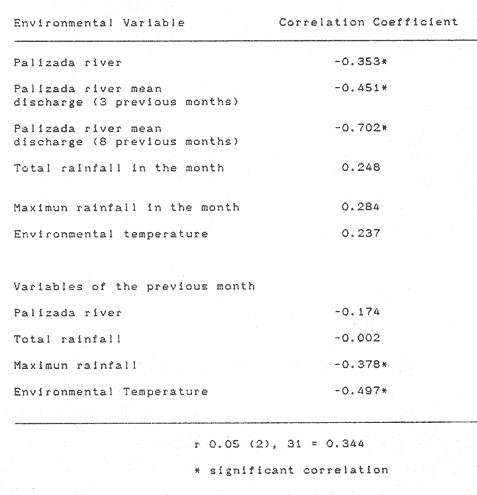 TABLE 1 CORRELATION COEFFICIENTS BETWEEN MONTHLY WHITE SHRIMP JUVENILE ABUNDANCE AND ENVIRONMENTAL VARIABLES When the previous month information was used, only a significant positive correlation with the temperature was observed (0.05 > P > 0.02). Palizada's river discharge during the previous month showed a negative correlation that did not reach significant values (P > 0.05). Multiple regression analysis applied to meteorologic variables included, within the model for the Palizada's discharge per month, the mean volume discharged of the 8 previous months and the temperature of the current. Variance explained by these reached 61%. When correlating juvenile abundance with records of the environmental variables for the previous month, the magnitude of variation expressed by the regression model decreased to 49%. Main variables causing the differences observed were: Palizada's discharge, mean flow of the 8 previous months and maximum rainfall. Correlation with these variables was negative in all cases. Palizada's discharge appeared as the main key variable, indicating changes in the juvenile abundance, therefore this correlation was more thoroughly analyzed. The curve of white shrimp juveniles abundance fitted, is comparable to a bell shaped curve (x², P < < 0.001). Nevertheless it shows a relatively high dispersion as shown in figure 4. This significant high variance could be related to other conditions, mainly biotic, and could be also reflecting sampling effects. 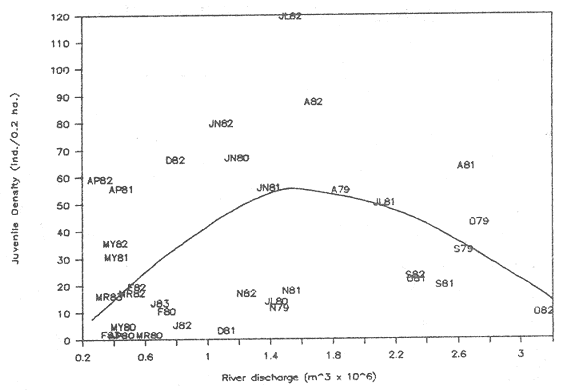 Figure 4. Relationship between white shrimp juveniles and Palizada river discharge to Términos Lagoon (1979-1982). TOTAL CATCH, SPAWNERS AND RECRUITS.
Monthly period
Total Catch per Unit Effort.Correlation coefficients of total catch and environmental monthly variables ranged from 0.03 (n = 48,P > 0.5) with highest rainfall to 0.60 (n = 48, P < 0.001), obtained with the mean river's discharge from the 8 previous months. Out of all the examined variables, only the mean value from 8 and 4 previous months. of the added flow of San Pedro, Boca del Cerro and Palizada rivers, San Pedro's flow and temperature showed statistically significant correlations (Table 2). Correlation with environmental temperature was negative, while in the others it was positive., If we take into consideration the four most important rivers that flow into the Campeche Sound and Terminos Lagoon (San Pedro, Boca del Cerro, Palizada and Candelaria), the correlation between abundance and mean flow 8 and 4 months. before, is similar to that obtained with just the data. from three rivers (0.60). As Candelaria's river data are not complete for the period analyzed, and considering that the three rivers taken as a whole represent a high correlation, it is preferable to use the latter. When the total catch per unit effort is related to environmental variables from the previous months, the obtained correlation coefficients are significant only for the Palizada, Boca del Cerro and Candelaria-Palizada flows combined. The influence of these variables is negative (Table 3). 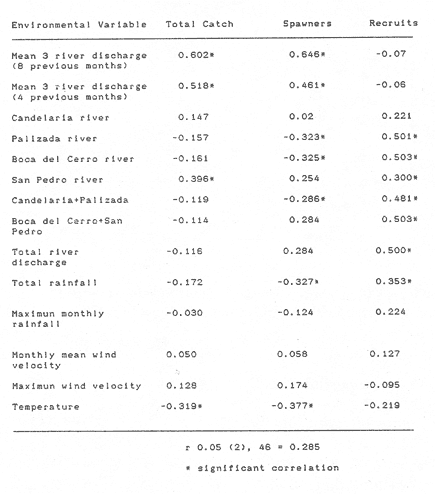 TABLE 2 CORRELATION COEMOENTS BETWEEN MONTHLY TOTAL, SPAWNERS AND RECRUITS CATCH PER UNIT EFFORT OF WHITE SHRIMP AND ENVIRONMENTAL VARIABLES IN THE CAMPECHE SOUND Spawners Catch per Unit Effort_Abundance of reproductive white shrimp showed a significant positive correlation with mean values for 8 and 4 months of fluvial discharge of the three rivers, and a negative correlation with the monthly discharge of Palizada, Boca del Cerro and Candelaria-Palizada (Table 2.) In this case, monthly total rainfall (0.05 > P > 0.02) and environmental temperature (0.01 > P > 0.005) had a significant negative correlation with the spawners catch per unit effort. Same as with the total CPUE records, highest correlations were obtained with the mean value of the three rivers' flow, with a 8 and 4 months lag. Candelaria, Palizada, Boca del Cerro, combined flows of these and month's rainfall, were the environmental variables which presented a significant negative correlation (0.05 >P > 0.001) when considering the records of the previous months (Table 3). 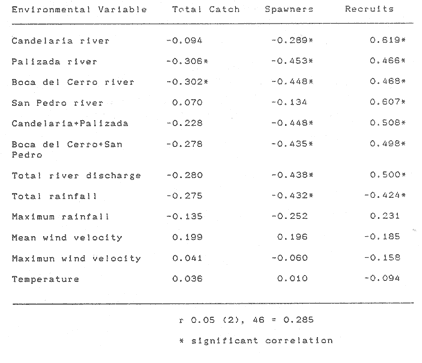 TABLE 3 CORRELATION COEFFICIENTS BETWEEN MONTHLY TOTAL, SPAWNERS AND RECRUITS CATCH PER UNIT EFFORT AND ENVIRONMENTAL VARLABLES OF THE PREVIOUS MONTH Catch of Recruits per Unit Effort.The index of monthly recruits abundance is significant correlated with the different fluvial discharge and combinations, except when taking the mean flows of the three rivers in two lags. Highest correlation values were obtained with the contribution of Palizada, Boca del Cerro and combined discharges. Total rainfall during the month also shows a statistically significant positive correlation, even though to a lesser degree as compared to river's discharge (Table 2). Correlation of previous months environmental variables with the recruits CPUE was significant and positive,whenever the rivers'discharge and total rainfall of the previous, month were considered. Highest correlations corresponded to those made with Candelaria and San Pedro flows (Table 3). MULTIPLE REGRESSION ANALYSISBased on monthly records of environmental variables, a stepwise multiple regression analysis was done in order to elaborate a descriptive model. With this technique the relationship between catch per unit effort and available environmental variables were examined.  TABLE 4 DESCRIPTIVE MODEL MULTIPLE REGRESSION FOR THE WHITE SHRIMP MONTHLY CATCH PER UNIT EFFORT, (TOTAL, SPAWNERS AND RECRUITS AND EN VIRONMENTAL VARIABLES. WHERE T = ENVIRONMENTAL TEMPERATURAE, A = CANDELARIA RIVER DISCHARGE, Ap = CANDELARIA RIVER DISCHARGE OF THE PREVIOUS MONTH, R8 = MEAN DISCHARGE OF THE THREE RIVERS DURING THE 8 PREVIOUS MONTHS, R4 = MEAN DISCRARGE OF THE THREE RIVERS DURING THE 4 PREVIOUS MONTHS, Pp = PALIZADA RIVER DISCHARGE OF THE PREVIOUS MONTH, C = TOTAL CPUE, S = SPAWNERS CPUE AND R = RECREA CPUE Total Catch per Unit Effort. Results obtained from multiple regresssions with total CPUE included in the model the mean discharge for the 8 previous months of the three rivers chosen, as well as the temperature of the environment of the previous month. Variance of total catch per unit effort explained by these two variables reaches 43%. The model is shown in Table 4. Spawners Catch per Unit Effort. The model obtained to examine the spawners abundance included only the mean discharge of the three rivers taken as a whole during the previous 8 and 4 months. Using this model, it is possible to explain 48% of the variation observed in the spawner catch (Table 4). Recruits Catch per Unit Effort. With respect to recruits abundance, variables included in the model through multiple regression, corresponded to the discharge of Candelaria and Palizada rivers during the previous month; as well as the contributed flow of Candelaria river during the current month. The level of monthly variation explained by these variables reached 60%, according to the estimates done (Table 4). Biological Years PeriodInformation of catch per unit effort arranged in biological years was correlated with the three rivers discharge, which was identified as the most important environmental variable. In this case the river discharge was combined aecording to the three climatic periods in the area. Total Catch per Un it EffortTotal catch per unit effort showed a significant linear positive correlation (0.002 > P > 0.005) with the mean flow of the three rivers during the current biological year, as well as with the rivers' contribution during the rainy season (P < 0.001, Table 5). The significant relationship with these two variables was mantained when correlating the magnitude of the rivers' discharge in the previous year with the catch per unit effort (Table 6). The three rivers discharge during the rainy season (0.005 > P > 0.002) and the annual discharge (0.001 > P > 0.005) showed a linear positive relationship (Fig. 5).  TABLE 5 CORRELATION COEFFICIENTS OF TOTAL, SPAWNERS AND RECRUITS CPUE PER BIOLOGICAL, YEAR WITH ANNUAL SEASONAL, RIVER DISCHARGE (DRY, RAINY AND NORTH WIND SEASONS) Spawners Catch per Unit EffortThe abundance of reproductive white shrimp was positively correlated with the mean annual discharge of the three rivers (0.005 '> P > 0.002) and with the discharge during the rainy season (P < 0.001, Table 5). Significant correlations were also, obtained with mean discharge of the rivers (0.05 > P > 0.02) when lagging the fluvial contribution values for a year (Table 6). The relationship kept between this variable and the rivers' flow was exponential (Fig. 5). Recruits Catch per Unit EffortFor this part of the white shrimp population, the only variable that showed a linear and significant positive correlation (0.02 > P > 0.01) was the mean discharge of the three rivers recorded in the y season of the same biological year (Table 5). The behavior of recruits with respect to the rivers' flow during the rainy season, fitted to a curve of the quadratic, type (Fig. 6). Recruits abundance decreased with respect to high rivers' flow, but the curve obtained is, interrupted at these levels, without: reaching minimum values. A linear relationship was fitted between recruits and y season rivers' discharge (Fig. 6) When correlating mean discharges of the previous biological year and recruits abundance, only a positive relationship with the rainy season discharge was found (0.05 > P > 0.02) (Table 6). 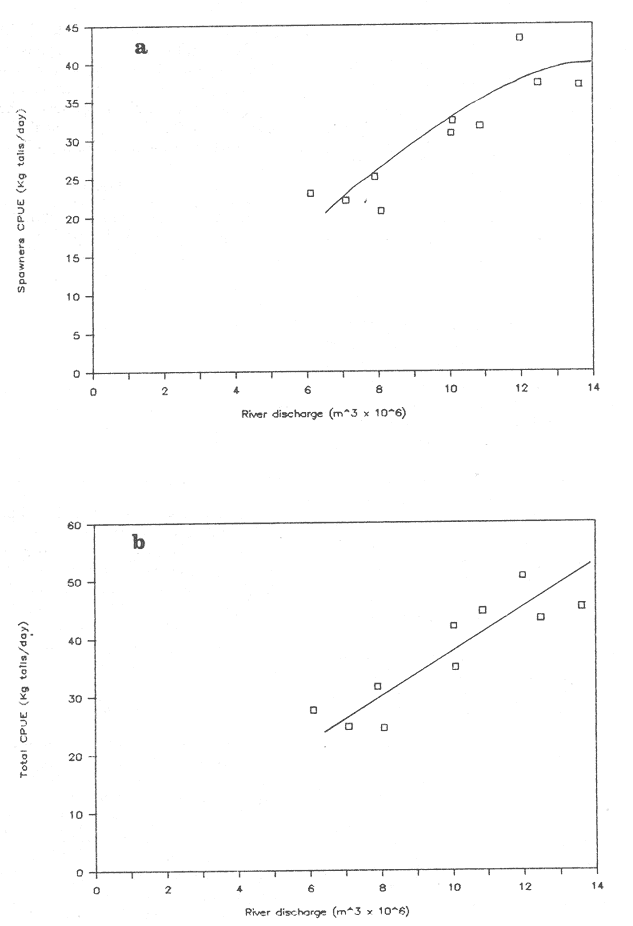 Figure 5. Relationship between Spawners (a), Total (b) CPUE and mean river discharge during the rainy seasons of the biological years in the 1974-1984 period. MULTIPLE REGRESSIONThe multiple regression analysis done for the rivers' flow considering climatic periods as independent variables and the CPUE of the different components of the white shrimp population for a biological year are shown in Table 7. Here it can be observed that the rivers' contribution during the rainy season represents the most important variable for the variance in total and spawners catch per unit effort. In the first case, the three rivers' flow during the rainy season explains 78% of the total catch per unit effort variance in the same year, and 81% of the variation in abundance of spawners. With respect to the recruits CPUE, the fluvial contribution in the dry season explains 58% of the variation observed in the catch. 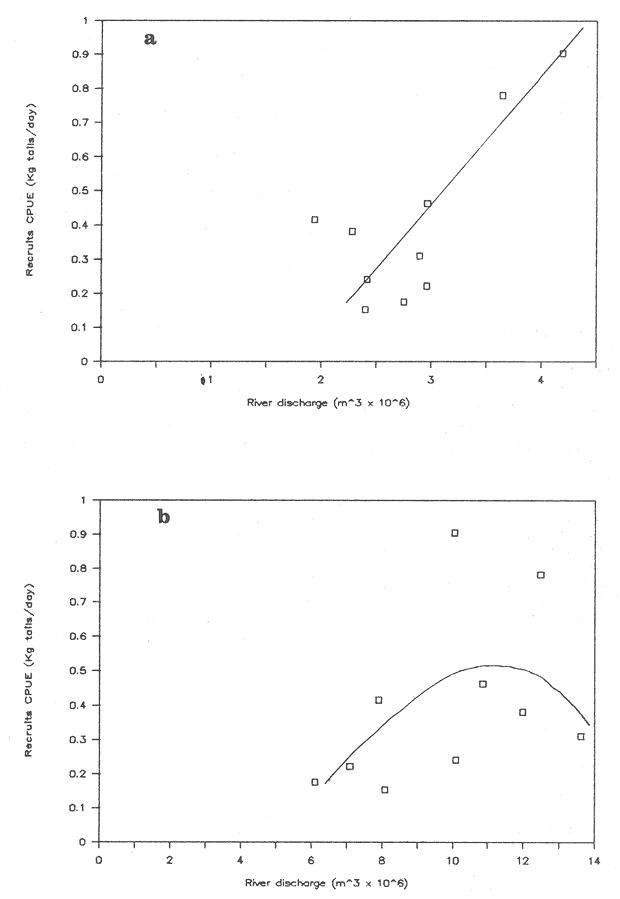 Figure 6. Relationship between RECREA CPUE and mean river discharge of the y (a) and rainy (b) seasons of the biological years in the 1974-1984 period. 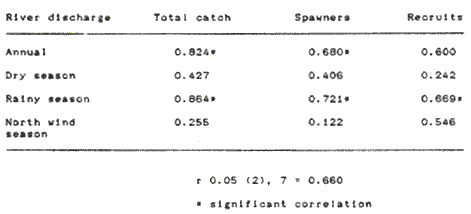 TABLE 6 CORRELATION COEFFICIENTS OF TOTAL, SPAWNERS AND RECRUITS CPUE PER BIOLOGICAL YEAR WITH THE ANNUAL SEASONAL (DRY, RAINY AND NORTH WIND SEASONS) RIVER DISCHARGE OF THE PREVIOUS YEARS When one year lag is applied to the discharge, the rivers'contribution during the rainy season is mantained as a variable of major influence on the variation of total catch and spawners. Variance explained by the fluvial flow at the previous year's rainfall of the climatic period, reaches 75% and 52% in the case of total and spawners CPUE, respectively. Recruits abundance is explained to a lesser degree (44%) by the annual discharge of the three climatic periods.  TABLE 7 DESCRIPTIVE MODEL MULTIPLE REGRESSION FOR TOTAL WHITE SHRIMP CATCH PER UNIT EFFORT, SPWANERS CPUE, RECRUITS CPUE AND SEASONAL RIVER DISCHARGE IN A BIOLOGICAL YEAR. WHERE L = RIVER DISCHARGE DURING THE RAINY SEASON, E= RIVER DISCHARGE DURING THE DRY SEASON, C - TOTAL CPUE, S= SPAWNERS CPUE AND R= RECRUITS CPUE THE IMPORTANCE OF THE RIVERS'DISCHARGE AND ITS RELATIONSHIP WITH THE WHITE SHRIMP ABUNDANCE.Among the variables examined through simple and multiple correlation analysis, the river's flow was outstanding as the most important variable which influences the abundance fluctuations of the white shrimp in the southern Gulf of Mexico. Even though regression analysis is not a proof of cause and effect, it suggests that the rivers' flow has a considerable influence on the catch. The correlation between river discharge and penaeid catch has been previously stated by different authors as positive and negative (García y le Reste,1981). This condition can be observed in white shrimp as positive (Gunter and Edwards, 1969) and negative (Barret and Gillespie, 1973; 1975) correlations with the rivers' discharge have been reported forP. setiferus for the northern Gulf of Mexico. The apparent contradiction of the effects of fresh water over the production of penaeids indicates that the relationship is not linear and changes after certain levels are reached. This is confirmed with the Gaussian type relationship observed between juvenile density in Terminos Lagoon and the flow level from the Palizada river (Fig. 4). Most hypotheses propose that the effect of the water flow is correlated with the nutrients contributed to the juvenile and adult distribution areas, and consequently affects the number of recruits. Browder and Moore (1981) suggest that fresh water flow to estuaries may be influencing, directly or indirectly, the fishery production, either through 1) Transport of nutrients, 2) Transport of detritus, 3) Transport and deposition of sediments, 4) Reduction of salinity and 5) Mixing and transport of water masses. The interaction of these factors results in an area with favorable salinities for the development of the organisms related to habitat stationary factors like depth, bottom. and coast type. The size of the resulting area, added to the concentration of nutrients, constitute the limiting factors for the establishment of P. setiferusin the estuarine stage (Gracia and Soto, 1986). The availability of space and food conform the matrix where the density-dependent factors will interact and affect the growth and survival of each cohort, and as a consequence their strength. The wide variance observed in the response curve of white shrimp juveniles to the rivers discharge could be related to these density-dependent factors. Seasonal sampling for the determination of the abundance of epibenthic postlarvae in adjacent small lagoons to Terminos Lagoon (Gracia, 1989) support the previous idea. The establishment of P. setiferus post-larvae in the San Francisco Lagoon (at the end of Palizada river, Fig. 1), over vegetation covered substrate, was only present during the dry season when salinity values were adequate. The increase in the rivers' discharge during the rainy and north wind seasons, decreased the salinity in the mentioned lagoon, and physiologically restricted the available habitat for the white shrimp. Related to this condition, the relationship between rivers' discharge and abundance of juveniles, fits to a bell shaped curve even though the overall tendency was towards negative correlations. The main effect of rivers'flow on the marine population could also be through the contribution of nutrients to the system, even though here other factors act and could modify the relationship river discharge-white shrimp abundance. Most of the correlations with the rivers' discharge were positive, and the fitted curves of total, spawners and recruits CPUE with the available data, were of the linear and exponential type (Figs. 5 and 6). In these cases a level of discharge, where the effect changes to negative is not appreciated. This could be due to the fact that those levels have not been reached, or else that it may be related with the marine environment that buffers the fluctuations in some way. The abnormal increase in rivers' discharge may have a negative effect in the long term over the level of white shrimp production due to the limitation of nursery arcas in the estuaries. Nevertheless, during short periods, the effect could be positive as decreasing salinity stimulates the migration of juveniles to the marine environment (Ruello, 1973; Staples, 1980). The combined effects of the variables through the development of a cohort partly explains why the mean flow of the rivers' during the 8 and 4 previous months is responsible for more than 40% of the variance in the monthly catches. The abundance of recruits, on the other hand, is more related to the discharge of the rivers' that flow into the Terminos Lagoon. When the biological year periods are used, the seasonal variance decreases and the discharge during the rainy season mostly explains the variation in the abundance of total and spawners catch. This is related with the short-lived condition of penaeids where the annual catch greatly depends on the most abundant recruited class during the year, an event that mainly takes place for the white shrimp during the rainy season. These recruits are mostly affected by the rivers' discharge in the y season when the development of juveniles occurs. The correlation between abundance of the white shrimp and climatic parameters with different lag periods could result in relationships merely by probability. In the case of lags included in the correlation and regression analysis, they were selected according to the life history main features of the white shrimp population, which gives them a biological sense and provides confidence in the observations made. It must be noted that the number of years examined is relatively low if fluctuations in the long term pretend to be examined. Nevertheless, the relationships obtained are enough to show that the annual variations observed in the abundance of white shrimp depend on the rivers's discharge. García and Le Reste (1981) suggest that the environmental parameters used, as rivers' discharge, rainfall, temperature or solar activity, may be key factors that could be related to others and could influence the biological production of shrimp populations. The empiric relationship established between rivers' discharge and white shrimp abundance could be considered as useful for the objectives of the present work, even though the determining mechanisms are not yet clearly understood. ConclusionesAmong the environmental factors analyzed, fluvial discharge showed to be the variable which mostly influences the abundance of juveniles, recruits, spawners and total catch. The rclationship between Palizada river's discharge and monthly abundance of juveniles was of the gaussian type. Mean abundance of recruits per biological year showed a linear relationship with fluvial flow during the dry season, and quadratic with respect to the rainy season. The spawners abundance per biological year and total catch had an exponential and linear relationship, respectively, with the mean rivers' discharge of the rainy season. Variations of rivers' discharge could exert a negative effect over the production levels of the white shrimp, through a limitation of the available area for the establishment of estuarine stages AgradecimientosOcean. Galo Escanero F. is greatly appreciated for kindly providing commercial shrimp catch records. Biol. Gerardo Hernández F. and Biol. José A. Genis V. are specially acknowledged for their support in gathering river discharge data. LITERATURAAGUILAR SIERRA, V. A., Tesis Prof. Fac. de Ciencias, Univ. Nal. Autón de México: Camarones peneidos de la Laguna de Términos, Campeche: Composición, Distribución y Parámetros Poblacionales.1985. 62 p. BARRETT, B. B. and M. C GILLESPIE,. L.A. Wildl. Fish Comm. Tech. Bull,Primary factors which influence commercial shrimp production in coastal Louisiana.1973. 28 p 9: BARRETT, B. B, L.A. Wildl. Fish. Tech. Bull,Environmental conditions relative to shrimp production in coastal Louisiana.1975.22p.15: BROWDER, J. A. and D. MOORE, Proccedings of the National Symposium on Freshwater Inflow lo Estuaries.U.S. Fish and Wildlife Service, Office of Biological Services. FWS/OBS-81/04: A new approach to determining the quantitative relationship between fishery production and the flow of fresh water to estuaries. In: Cross, R. y D. Williams (Eds.). 1981.403-430. Vol. 1. CRUZ-OROZCO, R. and F. LEY-LOU, An. del Inst. Geofísica, Resumen de las condiciones meteorológicas registradas en la Estación de Investigaciones Marinas "El Carmen", durante el año 1976. 1979a. 9 -18.25: CRUZ-OROZCO, R, An. del Inst. de Geofisica,Resumen de las condiciones meteorológicas registradas en la Estación de Investigaciones Marinas "El Carmen", durante el año de 1977.1979b.19-28.25: CRUZ-OROZCO, R., F. LEY-LOU, A. MACHADO-NAVARRO and V. M. AILBA-CORNEJO An. del Inst. de Geofísica, Resumen de las condiciones meteorológicas registradas en la Estación de Investigaciones Marinas "El Carmen", durante el año 1978.1979a.29-38.25: CRUZ-OROZCO, R, An. del Inst.de Geofísica, Resumen de las condiciones meteorológicas registradas en la Estación de Investigaciones Marinas "El Carmen", durante el año de 1979.1979b.39-52.25: GARCÍA, E., An. Inst. Geol,Modificaciones al sistema de clasificación climática de Koppen.UNAM:1973.9-84. GARCÍA, S. and L LE RESTE, Life cycles, dynamics, explotation and management of coastal penaeid shrimp stocks. FAO Fish. Tech. Pap., 1981. 215 p(203): GRACIA,A., Tesis Doctoral, Fac. de Ciencias, Univ. Nal. Autón de México,:Ecología y Pesquería del camarón blanco Penaeus setiferus (Linnaeus, 1767) en la Laguna de Términos-Sonda de Campeche.1989. 127 p. GRACIA, A. and L A. SOTO, IOC Workyhop Report No. 44:Condiciones de reclutamiento de las poblaciones de camarones peneidos en un sistema lagunar-marino tropical: Laguna de Términos-Banco de Campeche. IOC/FAO Workshop on Recruitment in Tropical Coastal Demersal Communities. In: A. Yáñez-Arancibia y D. Pauly (Eds.). 1986.257-265. GUNTER, G. and J. C. EDWARDS, FAO Fish Rep, (57)The relation of rainfall and freshwater drainage to the production of penaeid shrimp (Penaeus fluviatilis Say and Penaeus aztecus Ives) in Texas and Louisiana waters. 1969.87-92.Vol.3: MACHADO -NAVARRO, A. and P. LÓPEZ-LARA, Manuscrito inédito: Resumen de las condiciones meteorológicas registradas en la Estación de Investigaciones Marinas "El Carmen", durante el año de 1982. 1983.17 p. RUELLO, N. V., The influence of rainfall on the distribution and abundance of the school prawn, Metapenaeus macleayi, in the Hunter River region (Australia). Mar. Biol, 1973.221-228.23 (3): SMITH, M. K, Thesis Univ. of California, Berkeley,Some Ecological determinants of the growth and survival of juvenile penacid shrimp Penaeus setiferus (Linnaeus, in Términos Lagoon, Campeche, México, with special attention to the role of population density. Ph D.1984. 151 p. STAPLES, D. J., cology of juvenile and adolescent banana prawns Penaeus merguiensis in a mangrove estuary and adjacent off-shore area of the Gulf of Carpentaria. II Emigration, population structure and growth of juveniles. Aust J. Mar. Freshw. Res.,1980.653-665. 31: STAPLES, D. J., D. J. VANCE and D. S. HEALES, Second Australian National Prawn Seminar, NPS2, Cleveland, Queensland, Australia:Habitats requirements of juvenile penacid prawns and their relationship to offshore fisheries. In: Rothlisberg, P. C., B. J. Hill y D. J. Staples (Eds.).1985.47-54. VANCE. D. J., D. J. STAPLES and J. D. KERR, J. Cons. int. Explor. Mer., Factors affecting year-to-year variation in the catch of banana prawns Penaeus merguiensis) in the Gulf of Carpentaria, Australia.1985.83-97. 42: WITZELL, W. N. AND D. M. ALLEN, Summary of studies relating coastal climatological factors and commercial shrimp production, Southern United States. FAO Fish. Rep. (278), Suppl.:1983.111-119. YÁÑEZ-ARANCIBIA, A. and 3. W. DAY, Coastal Lagoons Oceanologica Acta, Vol. Spec.,Ecological characterization of Términos Lagoon, a tropical lagoon estuarine system in the southern Gulf of México. In: Lasserre, P. y H. Postma (Eds.). 1982.431-440.5 (4): YÁÑEZ-ARANCIBIA, A. and P. SÁNCHEZ-GIL, Caracterización ambiental, ecología y evaluación de las especies, poblaciones y comunidades. Inst. de Cienc. del Mar y Linmol Los peces demersales de la plataforma continental del sur del Golfo de México. 1. Univ. Nal. Autón de México, Publ. Esp.1986.1-230.9. ZAR, T. H., Prentice-Hall Inc. Englewood Cliffs. NJ.:Biostatistical Analysis. 1974.620 p.
|

